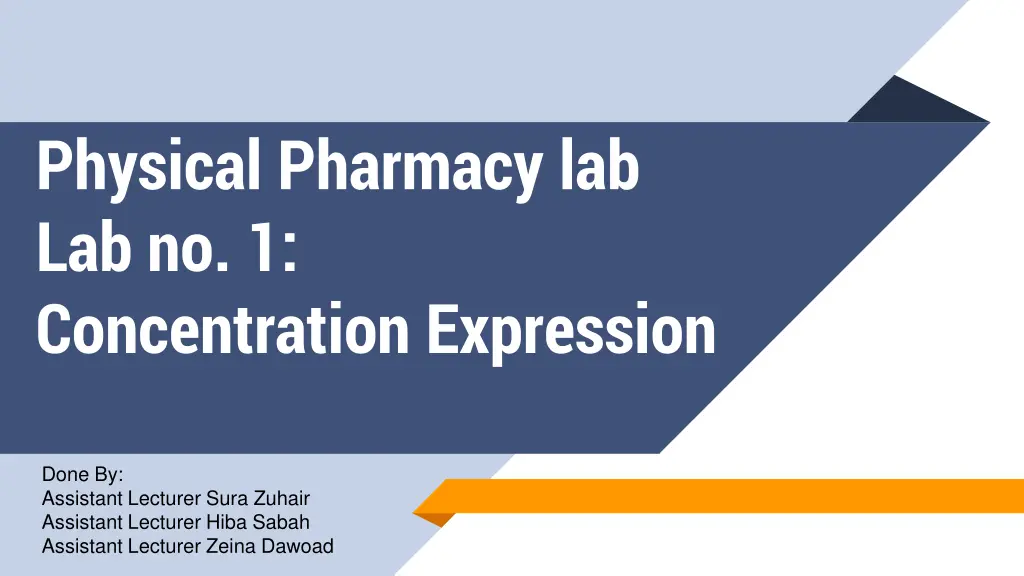
Concentration Expressions in Physical Pharmacy Lab
Explore concentration expressions in physical pharmacy lab, focusing on true solutions and pharmaceutical mixtures. Learn about the principles behind physical pharmacy and the types of solutions. Dive into the world of dispersion and understand how to calculate molarity for a given solution.
Download Presentation

Please find below an Image/Link to download the presentation.
The content on the website is provided AS IS for your information and personal use only. It may not be sold, licensed, or shared on other websites without obtaining consent from the author. If you encounter any issues during the download, it is possible that the publisher has removed the file from their server.
You are allowed to download the files provided on this website for personal or commercial use, subject to the condition that they are used lawfully. All files are the property of their respective owners.
The content on the website is provided AS IS for your information and personal use only. It may not be sold, licensed, or shared on other websites without obtaining consent from the author.
E N D
Presentation Transcript
Physical Pharmacy lab Lab no. 1: Concentration Expression Done By: Assistant Lecturer Sura Zuhair Assistant Lecturer Hiba Sabah Assistant Lecturer Zeina Dawoad
Introduction When the physical chemical and biological properties of drug molecules (i.e. preformulation) are understood, it is possible to design dosage forms for designated routes of administration in humans or animals (i.e., formulation). Collectively, the scientific principles applied in the preformulation and formulation processes is termed physical pharmacy, The term physical pharmacy stems from the application of physical chemistry principles to the area of pharmacy in the design of drug molecules and drug products. Lab for this course: Concentration expression, Two component systems containing liquid phases, Three component systems, The tie line for three component system, Partition coefficient, Buffer solutions and Solubility product constant for slightly soluble salt 2
Pharmaceutical mixtures Pharmaceutical mixtures True solution (<1 nm) (one phase system) Colloidal dispersion (1-500 nm ) (as liposome, microsphere) Coarse dispersion (> 500 nm )( as emulsion and suspension) 3
Dispersion :- is pharmaceutical mixture that consist of at least 2phases with on or more dispersed (internal phase )contained in a single continuous (external )phase. Phase :-is defined as the homogeneous physically distinct portion of the system separated from other parts of the system by bounding surface . 4
True True solution will be focused and discussed in this solution will be focused and discussed in this lab. It can be classified according to the lab. It can be classified according to the states which the solute and solvent occur, which the solute and solvent occur, and and because because 3 3 states of matter exist, states of matter exist, 9 9 types of homogeneous mixtures of solute of homogeneous mixtures of solute and solvent solvent are are possible. possible. states in in types and 5 5
examples Calculate the Molarity of solution containing 4 gm of NaOH in 500 ml solution (M.wt NaOH =40gm) M = wt * 1000 M.wt V(ml) M=4/40 * (1000/500) M= 0.2 M 8
Molality Calculate Molality of solution containing 2gm NaOH in 50 gm solvent ? molality = wt /M.wt * 1000/ gms of solvent m= 2/40 * 1000/ 50 m= 1 9
Q/ How many grams of KI (M.wt=166) are needed to prepare 25ml of 0.75 N solution? N= wt / eq.wt * 1000/ vol(ml) 0.75= wt / 166 * 1000 / 25 wt = 3.12 gm Q/ Solution prepared by dissolving 1 mole ethyl alcohol in 3 moles of water. Calculate mole fraction of each one? Mole fraction = moles of one constituent (solute) the total moles of all constituents (solute & solvent) Mole fraction of ethyl alcohol (x1) =1/1+3 = 1/4 = 0.25 Mole fraction of water (x2) = 3/1+3= 3/4 =0.75 (the sum of mole fraction is equal to one) 10
Mole percent 5%w/w NaOH mean 5 gm NaOH in 100 gm solvent 10%w/v NaOH = 10 gm NaOH in 100ml solvent 15 %v/v NaOH = 15 ml NaOH in 100ml solvent Q/prepare 25 gm of 4%w/w NaOH? 4gm 100gm X 25gm x= 1gm of NaOH with 24 gm of water Q/prepare 25 ml of 4%w/v NaOH? 4gm 100gm X 25ml x= 1gm of NaOH put in volumetric flask then complete the volume to 25 ml 11
Disadvantages of molarity & normality: 1-changing in value with temperature because of expansion or contraction of liquid so can not be use when studying properties of solution at various temp. 2-because Solvent volume in M&N are not really known it is difficult to study properties such as vapor pressure & osmotic pressure which are related to the conc. of solvent. (because Molality (m) has not the above disadvantages it is usedmorelikely in theoreticalstudies morethanN &M) 12
Experimental work: Materials and equipment: -NaCl, Na2CO3., NaOH, Alcohol, water. -Volumetric flasks (50cc), pipettes. M.Wt of NaCl =58.5 M.Wt of Na2CO3= 106 Prepare the following solution Prepare the following solution : A. 50 ml of 0.5 M NaCl. B . 50 ml of 2N NaCl. C. 50 ml of 0.1N Na2CO3. D. 50 ml of 0.1 M Na2CO3. E . 50 gm of 2% w/w NaCl solution. F. 50 ml of 10% w/v NaOH or NaCl. G. 50 ml of 10% v/v alcohol. Density = mass\volume Density of water =1 13






















